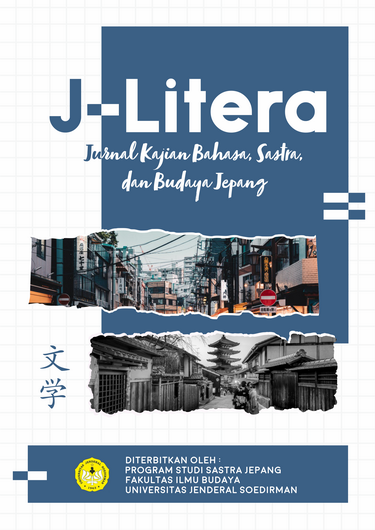MODALITAS EPISTEMIK KAMOSHIREMASEN DAN DESHOU PADA PIDATO ABE SHINZOU TENTANG COVID-19
Abstract
This research aims to analyze the structure and meaning and describe the similarities and differences of the epistemic modalities –kamoshiremasen and –deshou in 10 transcripts of Abe Shinzou's speeches at a press conference on covid-19.
In this research, the data were collected by means of a literature study from the website of the Japanese Prime Minister's secretarial office, namely www.kantei.go.jpg. To analyze the structure and meaning of the epistemic modality, a qualitative descriptive method is used. Meanwhile, to analyze the similarities and differences using the agih method. Thus, the data is presented in an informal form.
This research resulted in the finding that the epistemic modalities –kamoshiremasen and –deshou have similarities, namely they can be attached to verbs, i-adjectives, na-adjectives and nouns and can be placed in the middle and end of sentences. While the difference is the epistemic modality – kamoshiremasen states a possibility and general opinion with a low level of certainty, while the epistemic modality -deshou expresses a conjecture and confirmation with a high degree of certainty. In addition, this study also found an informal epistemic modality, namely kamoshirenai and darou.
References
Agusta, N. N. (2015). Modalitas Epistemik ~Darou dan ~Hazu dalam Kalimat Bahasa Jepang 日本語~だろう、~はずの認識モダリティ. Skripsi Sarjana: Universitas Diponegoro.
Alwi, H. (1992). Modalitas dalam Bahasa Indonesia. Yogyakarta: Kanisius.
Chaer, A. (2012). Linguistik Umum. Jakarta: Rineka Cipta.
Halliday, M., & Matthiessen, C. (2013). An Introduction to Functional Grammar (3rd ed.). London: Routledge.
Iori, I. (2000). Nihongo Bunpou Handobukku. Tokyo: 3A Corporatin.
Karomani. (2011). Keterampilan Berbicara. Tangeran Selatan: Matabaca Publishing.
Moleong, L. J. (2012). Metodologi Penelitian Kualitatif. Bandung: Remaja Rosdakarya.
Nitta, Y. (2003). Gendai Nihongo Bunpou (4) Modality. Tokyo: Kuroshio Shuppan.
Salsabila, D. A. (2020). Modalitas Epistemik Kamoshirenai, Ni Chigainai dan Hazu Da dalam Kalimat Bahasa Jepang 日本語におけるモダリティ「かも知れない」、「に違いない」、「はずに」. Skripsi Sarjana: Universitas DIponegoro.
Sudaryanto. (1993). Metode dan Aneka Teknik Analisis Bahasa: Pengantar Penelitian Wahana Kebudayaan secara Linguistis. Yogyakarta: Duta Wacana University Press.
Sudaryanto. (2015). Metode dan Aneka Teknik Analisis Bahasa. Yogyakarta: Sanata Dharma University Press.
Sunagawa, Y. (1998). Nihongo no Bunkei Jiten. Tokyo: 3A Corporation.
Sutedi, D. (2011). Dasar-Dasar Linguistik Bahasa Jepang. Bandung: Humaniora.
Syafnidawaty. (2020, October 29). Penelitian Kualitatif. Diambil kembali dari Universitas Raharja: https://raharja.ac.id/2020/10/29/penelitian-kuantitatif/
WHO, W. H. (2022, November 5). Coronavirus Disease (COVID-19) Pandemic. Diambil kembali dari WHO: https://www.who.int/emergencies/diseases/novel-coronavirus-2019
Wijana, I. D. (2015). Pengantar Semantik Bahasa Indonesia. Yogyakarta: Pustaka Pelajar.
Zain, M. (2014). Metode Penelitian Bahasa: Pendekatan Struktural. Padang: Penerbit FBS UNP Press.

This work is licensed under a Creative Commons Attribution-ShareAlike 4.0 International License.
Authors who publish with J-Litera: Jurnal Kajian Bahasa, Sastra dan Budaya Jepang agree to the following terms:
- Authors retain copyright and grant the journal right of first publication with the work simultaneously licensed under a Creative Commons Attribution License (CC BY-SA 4.0) that allows others to share the work with an acknowledgment of the work's authorship and initial publication in this journal.
- Authors are able to enter into separate, additional contractual arrangements for the non-exclusive distribution of the journal's published version of the work (e.g., post it to an institutional repository or publish it in a book), with an acknowledgment of its initial publication in this journal.
- Authors are permitted and encouraged to post their work online (e.g., in institutional repositories or on their website) prior to and during the submission process, as it can lead to productive exchanges, as well as earlier and greater citation of published work.













.png)




